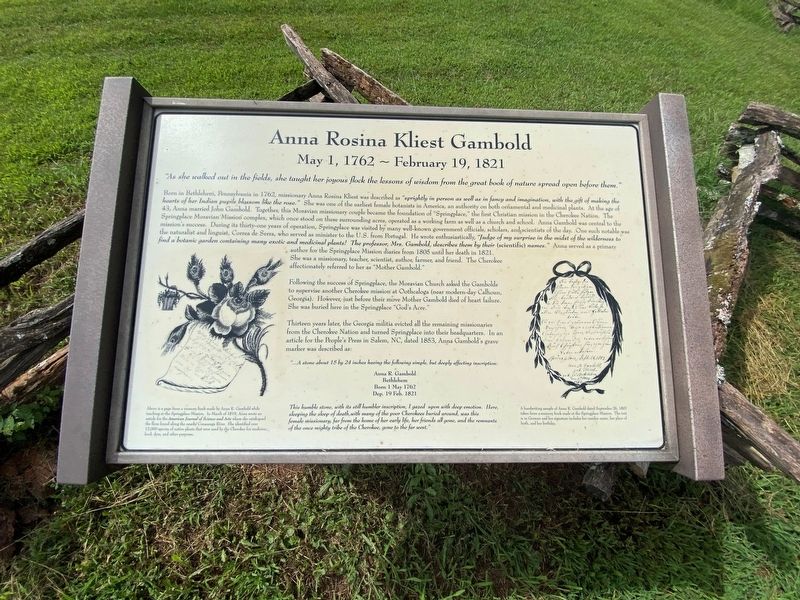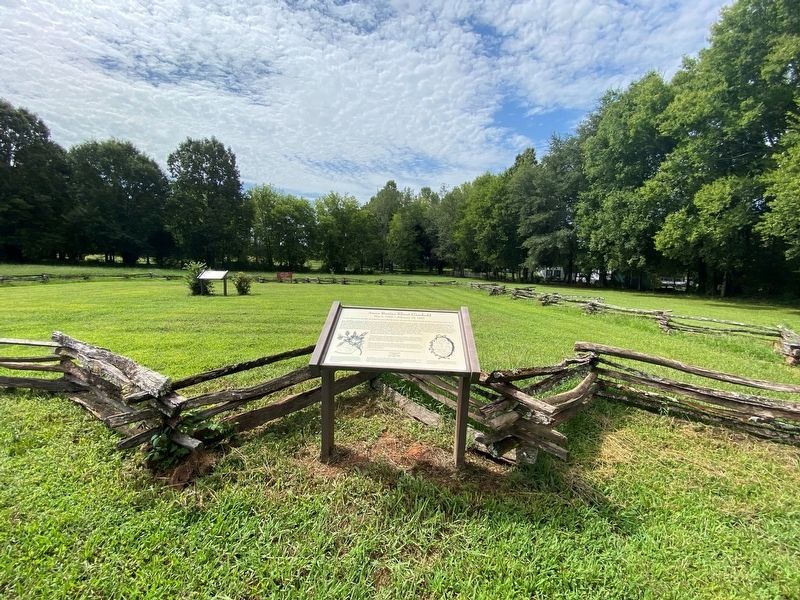Chatsworth in Murray County, Georgia — The American South (South Atlantic)
Anna Rosina Kliest Gambold
May 1, 1762 - February 19, 1821
"As she walked out in the fields, she taught her joyous flock the lessons of wisdom from the great book of nature spread open before them."
Born in Bethlehem, Pennsylvania in 1762, missionary Anna Rosina Kliest was described as "sprightly in person as well as in fancy and imagination, with the gift of making the hearts of her Indian pupils blossom like the rose." She was one of the earliest female botanists in America, an authority on both ornamental and medicinal plants. At the of age 43, Anna married John Gambold. Together, this Moravian missionary couple became the foundation of "Springplace,” the first Christian mission in the Cherokee Nation. The Springplace Moravian Mission complex, which stood on these surrounding acres, operated as a working farm as well as a church and school. Anna Gambold was central to the mission's success. During its thirty-one years of operation, Springplace was visited by well-known government officials, scholars, and scientists of the day. One such notable was the naturalist and linguist, Correa de Serra, who served as minister to the U.S. from Portugal. He wrote enthusiastically, "Judge of my surprise in the midst of the wilderness to find a botanic garden containing many exotic and medicinal plants! The professor, Mrs. Gambold, describes them by their (scientific) names.” Anna served as a primary author for the Springplace Mission diaries from 1805 until her death in 1821. She was a missionary, teacher, scientist, author, farmer, and friend. The Cherokee affectionately referred to her as "Mother Gambold."
Following the success of Springplace, the Moravian Church asked the Gambolds to supervise another Cherokee mission at Oothcaloga (near modern-day Calhoun, Georgia). However, just before their move Mother Gambold died of heart failure. She was buried here in the Springplace "God's Acre."
Thirteen years later, the Georgia militia evicted all the remaining missionaries from the Cherokee Nation and turned Springplace into their headquarters. In an article for the People's Press in Salem, NC, dated 1853, Anna Gambold's grave marker was described as:
"...A stone about 15 by 24 inches having the following simple, but deeply affecting inscription:
Anna R. Gambold
Bethlehem
Born 1 May 1762
Dep. 19 Feb. 1821
This humble stone, with its still humbler inscription, I gazed upon with deep emotion. Here, sleeping the sleep of death, with many of the poor Cherokees buried around, was this female missionary, far from the home of her early life, her friends all gone, and the remnants of the once mighty tribe of the Cherokee, gone to the far west."
(captions)
Above is a page from a memory book made by Anna R. Gambold while teaching at the Springplace Mission. In March of 1819, Anna wrote an article for the American Journal of Science and Arts where she catalogued the flora found along the nearby Conasauga River. She identified over 12,000 species of native plants that were used by the Cherokee for medicine, food, dyes, and other purposes.
A handwriting sample of Anna R. Gambold dated September 26, 1807 taken from a memory book made at the Springplace Mission. The text is in German and her signature includes her maiden name, her place of birth, and her birthday.
Topics. This historical marker is listed in these topic lists: Churches & Religion • Education • Native Americans • Women.
Location. 34° 45.669′ N, 84° 48.972′ W. Marker is in Chatsworth, Georgia, in Murray County. Marker is at the intersection of Georgia Route 52 and Ellijay Street, on the left when traveling west on State Route 52. Touch for map. Marker is at or near this postal address: 109 Ellijay St, Chatsworth GA 30705, United States of America. Touch for directions.
Other nearby markers. At least 8 other markers are within walking distance of this marker. The Moravian Mission to the Cherokee Indians (a few steps from this marker); Principal Chief Charles Renatus Hicks (a few steps from this marker); "God's Acre" (a few steps from this marker); Springplace Mission (a few steps from this marker); Springplace Moravian Mission & School (a few steps from this marker); Old Federal Road (approx. 0.3 miles away); John Howard Payne (approx. 0.3 miles away); Chief Vann House (approx. 0.4 miles away). Touch for a list and map of all markers in Chatsworth.
Also see . . .
1. Indian Missions. New Georgia Encyclopedia (Submitted on September 16, 2021.)
2. The Moravian Spring Mission Among the Cherokees. The National Archives and Records Administration (NARA) (Submitted on September 16, 2021.)
Credits. This page was last revised on September 16, 2021. It was originally submitted on September 16, 2021, by Darren Jefferson Clay of Duluth, Georgia. This page has been viewed 384 times since then and 79 times this year. Photos: 1, 2. submitted on September 16, 2021, by Darren Jefferson Clay of Duluth, Georgia. • Bernard Fisher was the editor who published this page.

